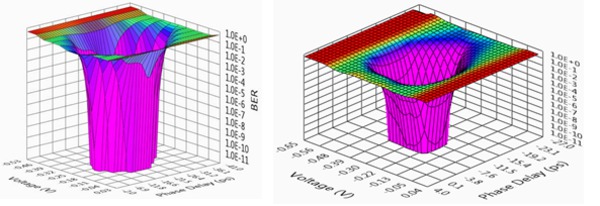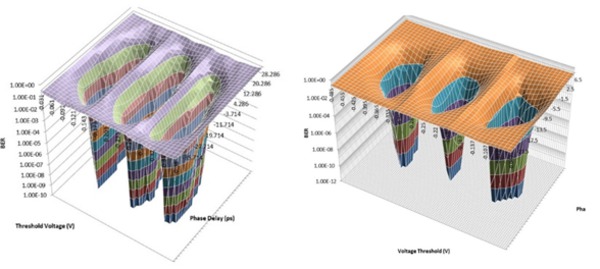
お問い合わせ
ダウンロード
マニュアル、データシート、ソフトウェアなどのダウンロード:
フィードバック
PatternPro® Error Detector
PED3200 and PED4000 Series Datasheet
このデータ・シートの製品は、テクトロニクスでは販売終了となっています。
Tektronix Encoreプレミアム再生品を見るbr/>
上記製品のサポートと保証のステータスをチェックする

The PED3200 and PED4000 series programmable error detectors offer effective multi-channel BER for stressed receiver testing of data communications designs. Available with full or half rate clock inputs.
Notice to EU customers
This product is not updated to comply with the RoHS 2 Directive 2011/65/EU and will not be shipped to the EU. Customers may be able to purchase products from inventory that were placed on the EU market prior to July 22, 2017 until supplies are depleted. Tektronix is committed to helping you with your solution needs. Please contact your local sales representative for further assistance or to determine if alternative product(s) are available. Tektronix will continue service to the end of worldwide support life.
Key performance specifications
- Data rate range:
- PED3200 series: 3 Gb/s to 32 Gb/s
- PED4000 series: 4 Gb/s to 40 Gb/s
Key features
- Available with 1 or 2 input channels (independent data on each channel)
- PRBS and user defined patterns
- High input sensitivity and bandwidth
- Auto-adjustment or manual adjustment of data to clock phase and threshold
- Auto-synchronization to input pattern
- PC GUI software:
- Remote instrument control
- Bathtub and Contour Analysis
- JTOL measurements
- J2/J9 measurements
- Front panel touch screen GUI or USB TMC computer control
Applications
- 25 Gb/s testing for 100G Ethernet
- 32 Gb/s DPQPSK testing
- Semiconductor and component testing
- Design validation and production testing
- Transmitter testing and validation up to 40 Gb/s
Product description
The Tektronix PED line of high sensitivity and high bandwidth error detectors offer single and two-channel standalone configurations capable of BER measurement at data rates up to 40 Gb/s. The PED products support either PRBS or user-defined data patterns, with simple to use automatic or manual alignment of input clock and data, and pattern synchronization. The PED product makes an ideal companion for the Tektronix PPG pattern generator product family.

100G Ethernet four lane end-to-end test using PED3200 series error detector and PPG3000 series pattern generator
Specifications
All specifications are guaranteed unless noted otherwise. All specifications apply to all models unless noted otherwise.
Data input
- Data rate
-
- Range (PED3200)
- 3 Gb/s to 32 Gb/s
- Range (PED4000)
- 4 Gb/s to 40 Gb/s
- Data input
- AC coupled input with broadband bias tees featuring a 3 dB bandwidth of 10 kHz to >50 GHz.
- Differential amplitude
- 6 mV to 1.0 Vp-p
- Single-ended amplitude
- 6 mV to 750 mVp-p
- Termination voltage
- 0.0 V
- Input impedance
- 50 Ω
- Connector
- 2.4 mm
- ESD sensitivity
- 250 V, Human body model (HBM)
Sampling point set points
- Eye edge BER threshold
-
- Range
- 1e-1 to 1e-11
- Resolution
- 1e-1
- Sync BER threshold
-
- Range
- 1e-1 to 1e-8
- Resolution
- 1e-1
Full rate clock input option
- Amplitude
- AC coupled, full rate
- Differential range
- 300 mVP-P to 1.0 VP-P
- Single-ended range
- 300 mVP-P to 1.0 VP-P
- Connector
- 2.4 mm
- Clock to data phase adjustment
- 100 ps (-50 ps to +50 ps)
- ESD sensitivity
- 1000 V, Human body model (HBM)
Half rate clock input option
- Amplitude
- AC coupled, half rate
- Differential range
- 300 mVP-P to 1.0 VP-P
- Single-ended range
- 300 mVP-P to 1.0 VP-P
- Connector
- 2.4 mm
- Clock to data phase adjustment
- 100 ps (-50 ps to +50 ps)
- ESD sensitivity
- 1000 V, Human body model (HBM)
Data patterns
- Pattern type
- Data (from memory) or PRBS.
Length and type are individually settable on each channel.
- PRBS pattern lengths
-
- 27 -1 bits
- Polynomial = X7 + X6 + 1
- 29 - 1 bits
- Polynomial = X9 + X5 + 1
- 211 - 1 bits
- Polynomial = X11 + X9 + 1
- 215 - 1 bits
- Polynomial = X15 + X14 + 1
- 223 - 1 bits
- Polynomial = X23 + X18 + 1
- 231 - 1 bits
- Polynomial = X31 + X28 + 1
- User-defined pattern depth
-
Number of channels Single bit pattern resolution 1 channel 4 Mbit 2 channels 2 Mbit
Mechanical
- Front panel width (with mounting tabs)
- 48.3 cm (19.0 in)
- Height
- 13.3 cm (5.25 in)
- Width
- 45.1 cm (17.75 in)
- Depth (rack mount)
- 34.3 cm (13.5 in)
- Weight (1 channel)
- 11.1 kg (24.5 lbs)
- Operating temperature
- 0 °C to 40 °C (32 °F to 104 °F)
Ordering information
Models
- PED3201
- 32 Gb/s Programmable error detector, 1 channel
- PED3202
- 32 Gb/s Programmable error detector, 2 channels
- PED4001
- 40 Gb/s Programmable error detector, 1 channel
- PED4002
- 40 Gb/s Programmable error detector, 2 channels
Options
Instrument options
- PED3201 HCLK
- Half rate clock input option for PED3201
- PED3201 FLCLK
- Full rate clock input option for PED3201
- PED3202 HCLK
- Half rate clock input option for PED3202
- PED3202 FLCLK
- Full rate clock input option for PED3202
- PED4001 HCLK
- Half rate clock input option for PED4001
- PED4001 FLCLK
- Full rate clock input option for PED4001
- PED4002 HCLK
- Half rate clock input option for PED4002
- PED4002 FLCLK
- Full rate clock input option for PED4002
Power plug options
- Opt. A0
- North America power plug (115 V, 60 Hz)
- Opt. A1
- Universal Euro power plug (220 V, 50 Hz)
- Opt. A2
- United Kingdom power plug (240 V, 50 Hz)
- Opt. A6
- Japan power plug (100 V, 50/60 Hz)
- Opt. A10
- China power plug (50 Hz)
- Opt. A11
- India power plug (50 Hz)
- Opt. A99
- No power cord
Manuals
- 071-3413-xx
- Printed PPG/PED Installation & Safety Instructions
- 077-1095-xx
- PED3200/PED4000 Series Programmable Error Detector User Manual, PDF-only, downloadable from Tektronix.com
PC Software GUI and Analysis Tool

25 Gb/s and 32 Gb/s NRZ Signal Contour Analysis
A PC-based software tool for remotely controlling the instrument, gathering and saving data (such as, bathtub and contour plots), and performing data systems analysis (J2/J9 and JTOL measurements) is available for use with both PED3200 and PED4000 error detectors. The tool is an executable file and is available upon request from Tektronix.

14 Gb/s and 25 Gb/s PAM4 Signal Contour Analysis



